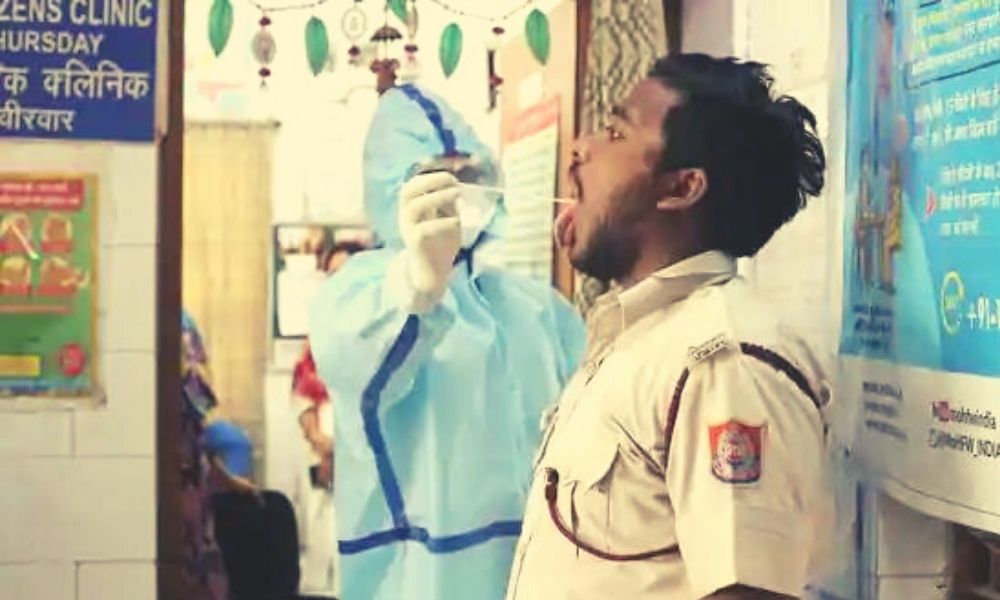
Image Credit: LiveMint
Is The Third Wave Of COVID Here Already?
Writer: Prattusa Mallik
A student of Journalism and Audio-Visual Communication, interested in words and silences alike, I aim to bring the narratives of the periphery to the centre, one story at a time. When not working, I'm usually caught reading, thinking, writing, watching Friends, or stargazing.
India, 5 Aug 2021 4:08 PM GMT
Editor : Madhusree Goswami |
A mountain girl trying to make it big in the city. She loves to travel and explore and hence keen on doing on-ground stories. Giving the crux of the matter through her editing skills is her way to pay back the journalism its due credit.
Creatives : Prattusa Mallik
A student of Journalism and Audio-Visual Communication, interested in words and silences alike, I aim to bring the narratives of the periphery to the centre, one story at a time. When not working, I'm usually caught reading, thinking, writing, watching Friends, or stargazing.
Researchers Mathukumalli Vidyasagar of IIT Hyderabad and Manindra Agrawal of IIT Kanpur prepared a mathematical model to predict when the third wave will likely hit India. According to their prediction, the country might witness a fresh surge in infections this month, with the third wave reaching its peak in October.
On Thursday, August 5, the Union Health Ministry data revealed that 42,625 people have tested positive for the coronavirus infection in a single day, taking the country's total tally to 3,17,69,132 and the active caseload to 4,10,353.
One obvious question that comes to the mind after reading such reports is that does this data indicate that the much-dreaded COVID third wave is here?
What Do The Experts Say?
One of the first medical bodies to confirm the possibility of a third wave was the Indian Medical Association (IMA) in mid-July. In the light of the government allowing religious festivals and tourism, IMA released a statement saying that the third wave of the pandemic was "inevitable and imminent", reported The Times of India. It urged the Central and state governments to ramp up the vaccination rates and not ease the restrictions, mainly because a considerable section of the population was complacent and participating in mass gatherings without adhering to COVID-appropriate protocols.
When Is The Wave Likely?
Researchers Mathukumalli Vidyasagar of IIT Hyderabad and Manindra Agrawal of IIT Kanpur prepared a mathematical model to predict when the third wave will likely hit India. According to their prediction, the country might witness a fresh surge in infections this month, with the third wave reaching its peak in October, reported India.com.
Elaborating further, the researchers noted that the country is expected to witness almost 1,50,000 infections per day in the worst-case scenario. In contrast, the numbers will come down to less than 1,00,000 cases per day in the best-case scenario. Though the third wave will not be as deadly as the second wave, states like Kerala and Maharashtra reporting a considerably higher number of cases might play a significant role in skewing that picture.
Which States Are The Worst-Hit?
The first state that has always been considered the worst hit in the country is perhaps Kerala. Right from the third wave, Kerala's curve has been very different from the country's average curve. With 51 per cent of the total COVID cases in the country, Kerala is witnessing a fresh surge in infections and is being touted by some as the future epicentre of the third wave. In the last six days, the state has witnessed 20,000 - 22,000 cases reported daily, with a TPR above 12 per cent, reported The Times of India.
What is worse is the fact that only 17 per cent of the state's population has been fully vaccinated so far, and the most dominant variant in the state has been the harmful Delta variant.
Another state which is also likely to be hit adversely by the third wave is Maharashtra. The state reported 6,479 new Covid-19 infections on Sunday, August 1, pushing the total count to 6,310,194 cases.
What Is The Way Out?
While the third wave seems inevitable, surrendering to it is not. As cliché as it might sound, experts have repeatedly mentioned how maintaining COVID appropriate protocols and getting vaccinated can help prevent the chances of getting infected. While states have complained about vaccination shortages in vaccine centres, some states have excelled in ramping up vaccination facilities.
For instance, on August 2, Bhubaneshwar claimed to have achieved100 per cent vaccination rate. According to the BMC jurisdiction, the state has administered as many as 18,77,178 vaccines by August 2. Of these, 10,71,676 received the first dose of vaccine, and 8,05,502 beneficiaries received the second dose.
Among other states that have performed well in ramping up the vaccinations is Bihar, which today became the first Indian state to clock the 5 crore vaccination mark as India administers over 48 crore doses so far. According to the ministry, 29,43,889 people in the 18-44 age group have been given the first dose, and 3,87,076 in the same category have been given the second dose so far.
Also read: Odisha's Sujal Mission Makes Puri First Indian City With 24/7 Drink-From-Tap Facility
 All section
All section














